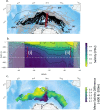Finding mesopelagic prey in a changing Southern Ocean
- PMID: 31831763
- PMCID: PMC6908696
- DOI: 10.1038/s41598-019-55152-4
Finding mesopelagic prey in a changing Southern Ocean
Abstract
Mesopelagic fish and squid occupy ocean depths extending below the photic zone and their vertical migrations represent a massive pathway moving energy and carbon through the water column. Their spatio-temporal distribution is however, difficult to map across remote regions particularly the vast Southern Ocean. This represents a key gap in understanding biogeochemical processes, marine ecosystem structure, and how changing ocean conditions will affect marine predators, which depend upon mesopelagic prey. We infer mesopelagic prey vertical distribution and relative abundance in the Indian sector of the Southern Ocean (20° to 130°E) with a novel approach using predator-derived indices. Fourteen years of southern elephant seal tracking and dive data, from the open ocean between the Antarctic Polar Front and the southern Antarctic Circumpolar Current front, clearly show that the vertical distribution of mesopelagic prey is influenced by the physical hydrographic processes that structure their habitat. Mesopelagic prey have a more restricted vertical migration and higher relative abundance closer to the surface where Circumpolar Deep Water rises to shallower depths. Combining these observations with a future projection of Southern Ocean conditions we show that changes in the coupling of surface and deep waters will potentially redistribute mesopelagic prey. These changes are small overall, but show important spatial variability: prey will increase in relative abundance to the east of the Kerguelen Plateau but decrease to the west. The consequences for deep-diving specialists such as elephant seals and whales over this time scale will likely be minor, but the changes in mesoscale vertical energy flow have implications for predators that forage within the mesopelagic zone as well as the broader pelagic ecosystem.
Conflict of interest statement
The authors declare no competing interests.
Figures




References
-
- Honjo S, et al. Understanding the role of the biological pump in the global carbon cycle: An Imperative for ocean science. Oceanography. 2014;27:10–16. doi: 10.5670/oceanog.2014.78. - DOI
-
- St. John, M. A. et al. A dark hole in our Understanding of marine ecosystems and their services: perspectives from the mesopelagic community. Front. Mar. Sci. 3, 10.3389/fmars.2016.00031 (2016).
-
- Holte J, Talley LD, Gilson J, Roemmich D. An Argo mixed layer climatology and database. Geophysical Research Letters. 2017;44:5618–5626. doi: 10.1002/2017gl073426. - DOI
Publication types
MeSH terms
Substances
LinkOut - more resources
Full Text Sources
Miscellaneous

